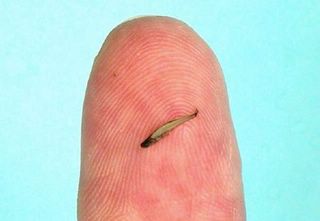** World's smallest fish?

According to a report published this week by the UK's Royal Society, a Swiss fish expert has discovered the world's littlest fish--a miniscule member of the carp family that reaches a maximum length of just 7.9 millimeters (that's less than a third of an inch).
Dubbed Paedocypris progenetica, the little swimmers have translucent bodies and no skulls to protect their tiny brains. They hail from peat swamps in tropical forests on the Indonesian island of Sumatra. The pools they live in are so acidic--100 times more so than rainwater--that scientists used to think they harbored little life. Turns out they harbor lots of life, including the world's littlest fish.
* * * * * *
Seriously? That's a Fish?
You may be wondering how anything so small could possibly count as a fish. Well, fishes are a highly diverse group. Around half of all vertebrate species--more than 25,000 of them--are fish species, and scientists still discover a handful of new ones every week.
There's plenty of debate about just how all those different fishes are related, but they generally have at least these three things in common:
1. They've got backbones--that's what it means to be a vertebrate.
2. They're cold-blooded.
3. They have respiratory organs that let them breathe underwater--gills.
Size really doesn't matter when it comes to fishiness. The previous recordholder for smallest fish, the stout infantfish, is only a few tenths of a millimeter longer than the Paedocypris progenetica. Meanwhile, the largest fish, whale sharks, grow to more than 30 feet (9 meters) in length. (Some researchers say whale sharks grow twice that big--it depends on whose fish stories you believe.)
So Many Fish in the Sea
Size variety is really just the start. There are jawless fishes like hagfish, the carcass-stripping vultures of the deep. There are jawed fishes like sharks and stingrays, with skeletons made of cartilage. And there are all the jawed fishes with bones--including perches, tunas, jacks, and thousands more.
There are also freshwater fishes--around 40 percent of all fish species--and saltwater fishes. And that's not to mention the handful of species that thrive in highly specialized spots, like icy-cold Antarctic waters, 100-degree hot springs, or acidic Sumatran peat swamps.
Unfortunately, many fish habitats are currently under pressure, including Sumatra's swamps. Expanding palm oil plantations and persistent fires (set, in some cases, by the plantation owners) are moving in on Paedocypris progenetica. Researchers fear that being the smallest fish in the world won't prevent it from one day being crowded out.
Steve Sampson
January 27, 2006



0 Comments:
Post a Comment
<< Home